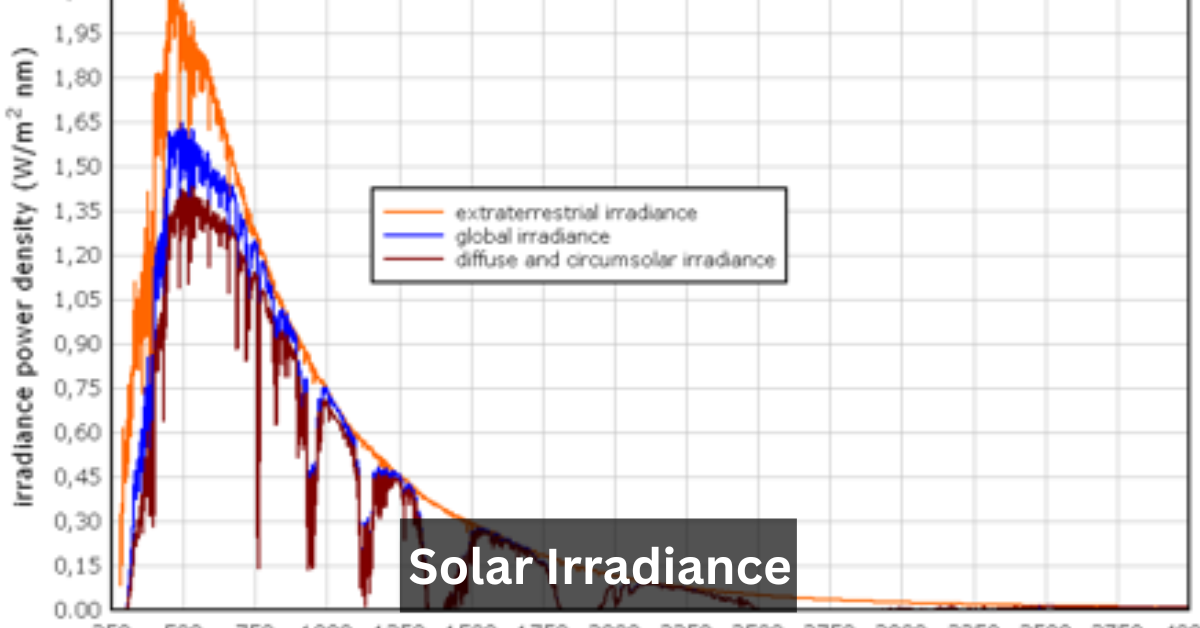Typically, values above 800 W/m² are considered high and optimal for solar panel performance. It represents the radiant energy received from the sun per unit area and is crucial for evaluating the performance of solar panels, designing photovoltaic systems, and conducting accurate climate research. Solar Irradiance, typically measured in watts per square meter (W/m²), varies based on geographic location, time of day, atmospheric conditions, and seasonal changes. This comprehensive guide explores all facets of Solar Irradiance, its types, measurements, variations, and real-world applications that shape the future of solar power.
What Is Solar Irradiance?
Solar Irradiance refers to the power of solar radiation per unit area received on a surface perpendicular to the sun’s rays. It is the foundational metric in solar energy analysis. Solar Irradiance is distinct from solar radiation or insolation, which measures the total energy received over time. By capturing this instantaneous measurement, scientists and engineers can estimate how much energy a given solar panel might produce at any moment. Whether it’s for a residential solar array or a large-scale solar farm, understanding Solar Irradiance is essential for system efficiency.
Solar Irradiance vs. Solar Radiation
Though often used interchangeably, Solar Irradiance and solar radiation differ in scope. Solar Irradiance is the immediate power received, whereas solar radiation encompasses energy over a duration. Solar radiation is typically expressed in kilowatt-hours per square meter per day (kWh/m²/day). When optimizing solar panels, Solar Irradiance offers real-time insights, helping in fine-tuning parameters such as optimal tilt angle and orientation.
How Solar Irradiance Is Measured
To accurately assess Solar Irradiance, scientists use advanced instruments like the pyranometer, pyrheliometer, and solarimeter. A pyranometer measures global horizontal irradiance (GHI), which includes both direct sunlight and diffuse sky radiation. A pyrheliometer measures direct normal irradiance (DNI), requiring alignment with the sun’s position. These devices provide crucial data in watts per square meter (W/m²), enabling precise monitoring and optimization of solar energy systems.
Units of Solar Irradiance: Watts per Square Meter
Solar Irradiance is measured in watts per square meter (W/m²), offering a clear representation of solar power at a specific location and time. This unit allows comparisons across regions and system designs, ensuring that solar technology performs efficiently under varying sunlight conditions. Understanding this measurement helps both scientists and solar installers assess potential energy yields.
Types of Solar Irradiance
There are three primary types of Solar Irradiance: Global Horizontal Irradiance (GHI), Direct Normal Irradiance (DNI), and Diffuse Horizontal Irradiance (DHI). GHI measures total solar radiation on a flat surface and is the most common metric in photovoltaic system design. DNI measures direct sunlight reaching the Earth’s surface in a straight line and is used primarily in concentrated solar power (CSP) systems. DHI measures scattered sunlight and is essential for understanding the total solar resource under cloudy or hazy conditions.
Comparing GHI, DNI, and DHI
Each type of Solar Irradiance plays a unique role. GHI is ideal for fixed-tilt PV panels, while DNI is crucial for tracking systems and CSP technologies. DHI becomes significant in regions with frequent cloud cover, where diffuse sunlight contributes heavily to energy generation. By analyzing all three, engineers can tailor system designs for maximum output.
The Solar Constant and the Earth’s Atmosphere
The solar constant, approximately 1361 W/m², is the average Solar Irradiance received at the outer edge of Earth’s atmosphere. However, once solar radiation enters the atmosphere, factors like air mass, water vapor, dust, and pollution reduce the intensity of Solar Irradiance that reaches the ground. These atmospheric effects are key considerations in solar site assessments and modeling tools.
Impact of Atmospheric Conditions
Atmospheric elements such as clouds, smog, and altitude significantly impact Solar Irradiance levels. High-elevation areas with thinner air tend to receive stronger irradiance, while lowland urban areas may suffer reduced sunlight due to pollution. The presence of dust particles can scatter solar rays, lowering DNI but potentially increasing DHI, altering the overall efficiency of solar panels.
Daily and Seasonal Solar Irradiance Variations
Solar Irradiance fluctuates throughout the day, peaking around solar noon and dropping to zero at night. This daily cycle, known as diurnal variation, influences battery storage sizing and energy management strategies. Seasonally, the Earth’s tilt causes variations in Solar Irradiance by location, with equatorial regions enjoying more consistent exposure compared to high-latitude regions.
Solar Irradiance by Geographic Location
Geography plays a critical role in Solar Irradiance. Regions like the Sahara Desert receive exceptionally high GHI due to minimal cloud cover and high solar angles. In contrast, Northern Europe experiences lower average Solar Irradiance levels, which must be compensated through efficient panel placement, use of the optimal tilt angle, and advanced tracking systems.
Real-Time Solar Irradiance Data and Monitoring
Modern solar installations benefit from real-time Solar Irradiance monitoring systems. Tools like NASA POWER Data, PVGIS, Solcast, and Meteonorm provide valuable insights into Solar Irradiance patterns. With APIs and satellite integration, users can forecast solar energy output, optimize system performance, and plan for cloudy or sunny days ahead.
Solar Irradiance and Photovoltaic Efficiency
Solar Irradiance directly influences photovoltaic efficiency. Under standard test conditions (STC), panels are rated at 1000 W/m² of irradiance. Real-world conditions, however, often differ, making real-time data and Solar Irradiance graphs essential for accurate performance evaluations. Knowing when irradiance is at its peak helps determine the most effective energy usage and storage strategies.
Solar Irradiance in PV System Design
Effective photovoltaic system design relies heavily on Solar Irradiance data. Engineers use irradiance maps and solar resource assessments to determine system size, orientation, and financial return on investment. Using historical and real-time data ensures each component, from panels to inverters, operates at optimal levels year-round.
Climate Impact of Solar Irradiance
Solar Irradiance isn’t just for energy systems—it’s a vital parameter in climate modeling. Organizations like NASA, NOAA, and the IPCC use Solar Irradiance measurements to understand global temperature trends and assess the effects of climate change. Variations in irradiance over decades are studied for their influence on Earth’s climate systems.
Tools and Resources for Solar Irradiance Tracking
For precise solar planning, tools like Meteonorm, PVGIS, and NASA POWER provide robust irradiance databases. These resources help homeowners, engineers, and researchers predict energy production, conduct feasibility studies, and design better solar energy systems using real-world and simulated Solar Irradiance data.
Solar Irradiance vs. Insolation
Understanding the distinction between Solar Irradiance and insolation is essential. While Solar Irradiance measures power at a moment, insolation quantifies the energy accumulated over time. Daily and monthly insolation charts help in long-term planning, while Solar Irradiance data is vital for instant decision-making and monitoring.
Challenges in Measuring Solar Irradiance
Despite technological advances, Solar Irradiance measurement faces challenges. Calibration of sensors, shadowing from nearby structures, and environmental factors can lead to inaccurate readings. Engineers must account for these variables by regularly maintaining equipment and factoring in potential obstructions.
Future Trends in Solar Irradiance Research
The future of Solar Irradiance research looks bright. Innovations like space-based solar observatories and AI-powered forecasting models are pushing the boundaries of solar prediction. Machine learning tools analyze vast irradiance datasets to enhance accuracy and predictability, ensuring smarter energy systems.
Conclusion
Solar Irradiance remains the cornerstone of solar energy systems. With its influence spanning system design, climate studies, and technological innovation, it drives the global transition toward renewable energy. By understanding Solar Irradiance deeply, we can build smarter grids, optimize photovoltaic performance, and take bold steps toward a sustainable future.
Frequently Asked Questions
Can I check Solar Irradiance in my area?
Yes. Use platforms like Solcast, PVGIS, and NASA POWER to view real-time and historical irradiance data for any location.
How does Solar Irradiance impact my solar bill savings?
Higher Solar Irradiance means greater energy production, which can significantly reduce electricity bills.
What is the ideal irradiance for solar panel performance?
The ideal is around 1000 W/m² under standard test conditions. Real-world performance depends on site-specific conditions.
Is Solar Irradiance affected by pollution or fog?
Yes. Air pollution and fog scatter sunlight, reducing direct irradiance and affecting overall system efficiency.
Stay in touch to get more updates & alerts on Erome! Thank you



